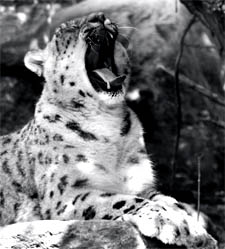
A growing number of people are encroaching on the snow leopard’s habitat by introducing livestock, which displaces wild sheep and goats—the snow leopard’s natural prey. This forces the leopards to turn their attention to the livestock, resulting in devastating economic losses to poor, rural farming communities whose livestock are a source of food, raw materials for clothing, and income through the sale of wool and dairy products. To help prevent further losses, the offending cat is frequently killed.
In addition, snow leopards are lost every year to poaching. Their hides and bones can bring a very high price on the black market.
Over the years, many conservation actions and practices to protect the snow leopard have been tried and tested. Those that have been successful and sustainable are programs that link economics with conservation. Some of these practices may not be appreciated by traditional conservationists, but no one can refute the success of these actions. The saying, “when it pays, it stays,” rings true with snow leopard conservation. Locals have realized that their income and prosperity are linked with the protection of wildlife. For conservation efforts to be effective, it is crucial to involve people who share the snow leopard’s mountain environment and provide them with economic incentives for enhancing and protecting the habitat.
An example of a market-driven program that has improved local economies and high mountain ecosystems is the Snow Leopard Enterprise. This organization helps hundreds of women across Central and South Asia by giving them the training and equipment necessary to produce handfelted wool products that are sold internationally through the Snow Leopard Trust online store and other venues. This new source of income enables women to buy food, medicine, and schooling for their children. The herding communities in which they live no longer have to rely on money from poaching endangered snow leopards to survive. All profits from Snow Leopard Enterprise are invested back into community conservation projects that generate income and help protect snow leopards and their habitat.
Another example is found in Chitral, Pakistan, where Snow Leopard Enterprise has worked to promote good animal husbandry and trophy hunting for markhor (wild goat), creating safe corridors and grazing places for snow leopards. By enhancing habitat to boost the market for hunting markhor, a wild prey of the snow leopard, the leopard population also increases.
Per the agreement between the wildlife department and the local communities, livestock is not allowed in the wild ungulates grazing zones during certain times of the year. According to the agreement, 80 percent of the proceeds of the trophy hunting revenue go to the village conservation committees and the remaining revenue is taken by the government. If locals violate the agreement, they risk losing their incentive-based annual income that they receive in return for their participation in habitat conservation.
Since the agreement went into effect, the snow leopard is actually protected by the locals and frequently seen in the Chitral area. Despite insecure conditions in this area, there has been a 10 to15 percent increase in local tourism that is attributed to the presence of the snow leopard. Its wild prey base is abundant here and is attracting large numbers of foreign tourists as well. Sightings are so frequent that snow leopards were filmed by “Planet Earth,” a nature television show, near Chitral Gol National Park in 2006—the first good footage of snow leopards in the wild.



